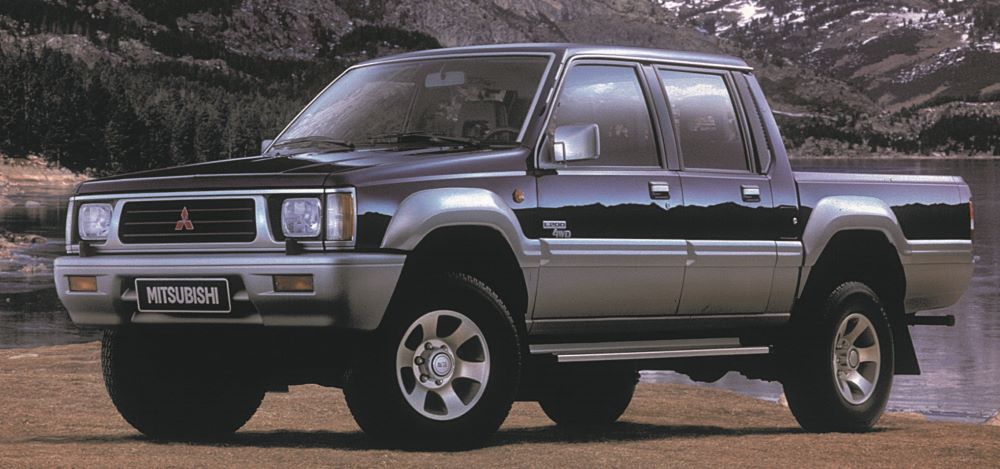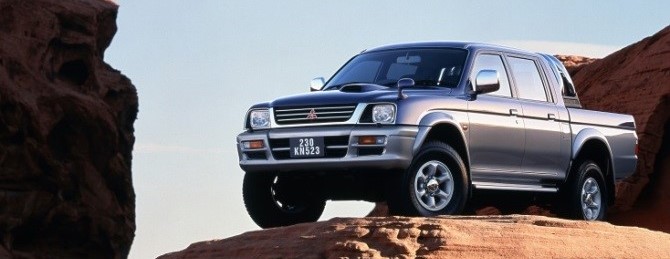
Also called
- Mitsubishi Forte
- Mitsubishi Strada
- Mitsubishi Triton
1st Generation 1978 FORTE/L200
There is a huge overseas demand, particularly in North America, for small pickup trucks, where they are used casually for commuting to school and work, as well as for recreation.
Mitsubishi Motors introduced its first 1-ton pickup truck with the name FORTE/L200 in September 1978, and began to export to North America from the following October.
The name for the 1-ton pickup truck “FORTE” means “strong” in Italian. The prototypes underwent rigorous endurance testing on a massive scale in North America, Thailand, and Saudi Arabia to ensure reliability. A total of approximately 657,000 vehicles were produced in the Ohe Plant in Japan, and partially in the Laem Chabang Plant in Thailand.
The styling took its cues from the compact sedan GALANT Σ, with a long nose, an air-dam skirt which was introduced for trucks for the first time, and four round headlights. The L200/FORTE was powered by a 2.0-litre and 2.6-litre petrol engines for North America and 1.6-litre petrol engine for Japan and other regions. A 2.3-litre diesel engine was available for general exports. Its wide 1,360mm front track and long wheelbase of 2,780mm ensured superior driving stability.
The chassis was sophisticated for a commercial vehicle too, with front disc brakes, double wishbone/coil springs for the front suspension, and leaf springs and rigid axle in the rear.
The very quiet interior results from an uncompromising approach to NVH performance, which includes the use of a 2-piece prop shaft and the generous use of strategically-placed sealing materials.
Mitsubishi Motors leveraged its many years of experience of building Jeeps, and added a newly-developed part-time 4WD transfer system with a directly-linked silent chain. This system reduced gear noise and power loss, and enabled high-speed on-road driving.
This model served as the forerunner for Mitsubishi Motors’ 4WD lineup such as the SHOGUN and the DELICA.
November 1995
- The new pickup truck model L200 was introduced in Thailand.
- Production is concentrated in the MSC Thai Laem Chabang Plant, from where it is exported worldwide.
- Three body variations include Single Cab, Club Cab, and Double Cab for exports. Powered by 2.5-litre diesel engines. The 4WD mechanism is equipped with innovative “Easy Select 4WD” system.

2nd Generation 1986 STRADA/L200
There was a full model change in March 1986.
The exterior sports a classy makeover with a new front grille design, among other detail changes. And the lines create a shape that looks as tough and modern as it is aero-efficient.
A wider variety of configurations were offered, including three body types: Single Cab, Club Cab, Double Cab, short and long body style available for Single Cab, 2WD and 4WD drivetrain options, 2.0-litre and 2.6-litre gasoline engines, and 2.5-litre diesel engine.
The naming changed too, with double-cab L200/STRADA being introduced in Japan in 1991. The model was also called MIGHTY MAX in North America, TRITON in Australia, and L200 in other areas. In North America, it was also sold by Dodge as the RAM 50.
A total of approximately 1,146,000 2nd generation models were produced in the Ohe Plant in Japan, and the Laem Chabang Plant in Thailand.
March 1986
- Full model change. Variations now offered included three body types: Single Cab, Club Cab, Double Cab with short and long body styles available with the Single Cab. New 2WD and 4WD drivetrain options were available, with 2.0-litre and 2.6-litre petrol engines and 2.5-litre diesel engine (increased from 2.3-litre).
May 1991
- Introduced as STRADA into the Japan market (double-cab only)

3rd Generation 1995 L200
Production of the third generation L200/STRADA began in November 1995 in Thailand. The interior and exterior designs were fully revised to give a distinctive and cutting-edge look.
The new style reflected the customer need to have a pickup truck which could also be used as a passenger car for personal use. The model was positioned as a roomy five seater that was comfortable and capable enough for both recreational and commercial uses.
Power and off-road performance were improved with a 2.5-litre intercooled turbodiesel engine and features such as “Easy Select 4WD.” Safety and equipment levels were also enhanced to match the expectations of buyers used to passenger car levels of comfort.
The L200/STRADA was sold in Thailand and also exported to Europe, Oceania, Latin America, the Middle East and Africa. A total of approximately 1,046,000 vehicles were produced.
It featured:
- A fresh new look that combines the toughness of a pickup truck with the style of a passenger car
- An interior with a passenger car feel, featuring moulded door trimmings and oversized padding for comfort
- A roomy cargo area that is among the largest in its class
- The 2.5-litre turbodiesel intercooled engine with better drivability
- Enhanced passive and active safety features such as driver-side airbag, anti-pinch power windows, and high level brake lights
- Mitsubishi Motors “Easy Select 4WD” system was adopted, with its synchronized free-wheel front differential that allows the driver to choose the most efficient drive mode for any road surface.
- Available on some trim levels are: Mitsubishi Motors ABS, which prevents the wheels from locking up during braking to stabilize body attitude and handling; and a hybrid limited slip differential (LSD) that enhances driving stability
November 1995
- The new pickup truck model L200 was introduced in Thailand.
- Production is concentrated in the MSC Thai Laem Chabang Plant, from where it is exported worldwide.
- Three body variations include Single Cab, Club Cab, and Double Cab for exports. Powered by 2.5-litre diesel engines. The 4WD mechanism is equipped with innovative “Easy Select 4WD” system.
It’s 1978, and the world is changing. Space Invaders spreads to arcades across the globe and launches the video game industry. The first automated cellular phone network is being built in Japan and Superman takes off in cinemas.
Another product is launched which, over the next four decades, will bring mobility to 4.7 million people – the Mitsubishi 1-ton pickup.
It’s a pickup truck that can handle all types of road, anywhere on the planet. It has been developed with a design brief – to meet the desire of customers for a pickup with outstanding reliability, durability and payload performance; with levels of drivability, utility, comfort and ride that are on a par with a passenger sedan.
The first models were appropriately named FORTE, although other badges used included L200, which remain in use today. From the very beginning, the L200 was engineered to provide tough, dependable transport for people and goods.
The L200 was developed to provide a 1-ton carrying capacity and yet be as easy to drive, have a combination of rugged reliability, easy-to-drive nature and impressive carrying capacity. This soon made it a firm favourite across the world, from frozen wastes to sun-baked deserts.
To ensure customers could go even further afield, Mitsubishi Motors built on its four-wheel-drive heritage by adding a 4×4 version to the range in 1980. This became the foundation for modern Mitsubishi 4WD vehicles, leading directly to the SHOGUN and DELICA.
The L200 pickup, renamed TRITON in some markets, had a profound effect on the Mitsubishi Motors’ business too. The first and second generation platforms were mainly produced at Mitsubishi Motors Ohe Plant. Since the third-generation model in 1995, production has been concentrated in the Laem Chabang Plant in Thailand, from where they are exported worldwide. It is now Mitsubishi Motors’ biggest factory, producing about 400,000 vehicles.

You must be logged in to post a comment.